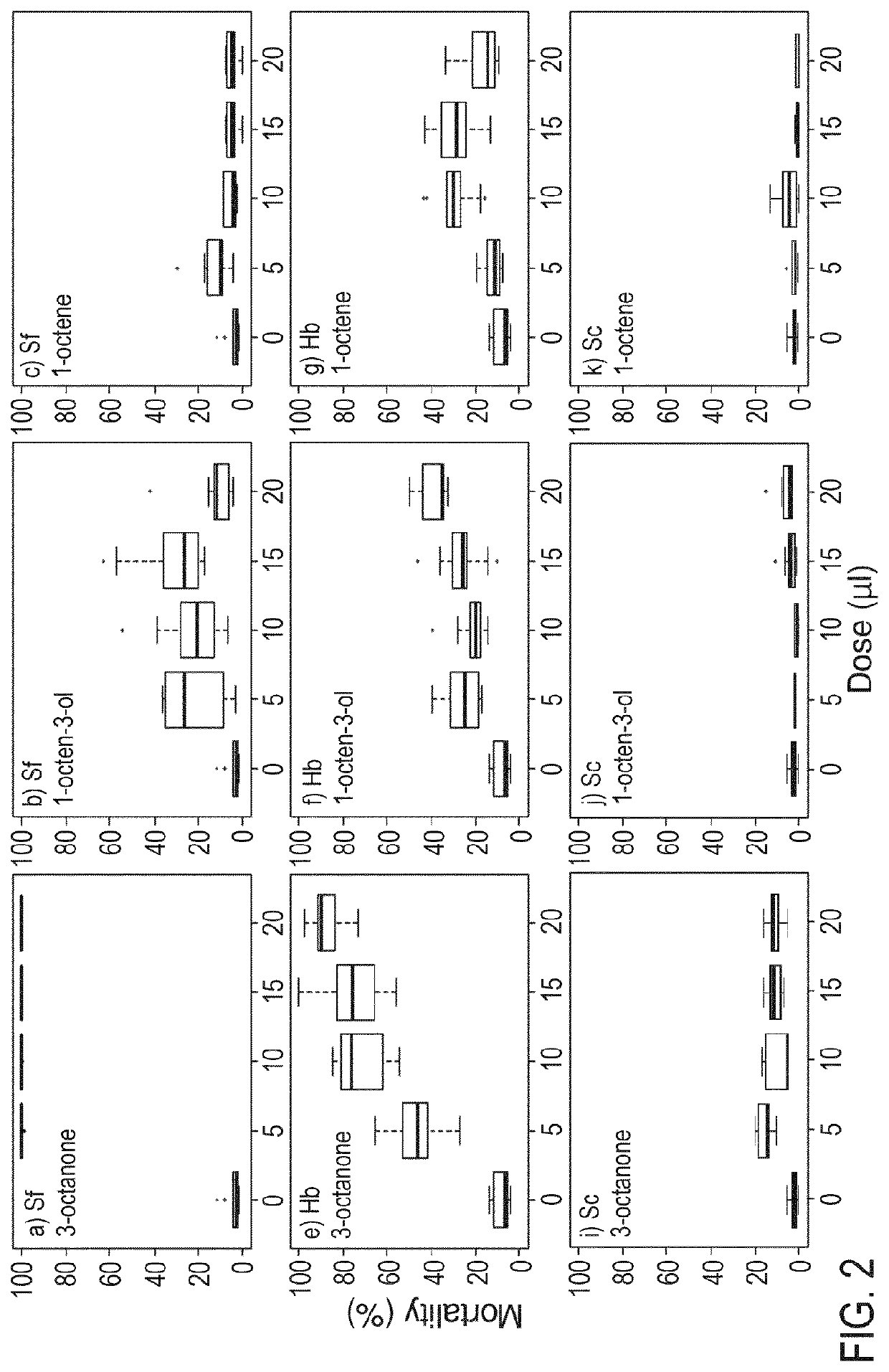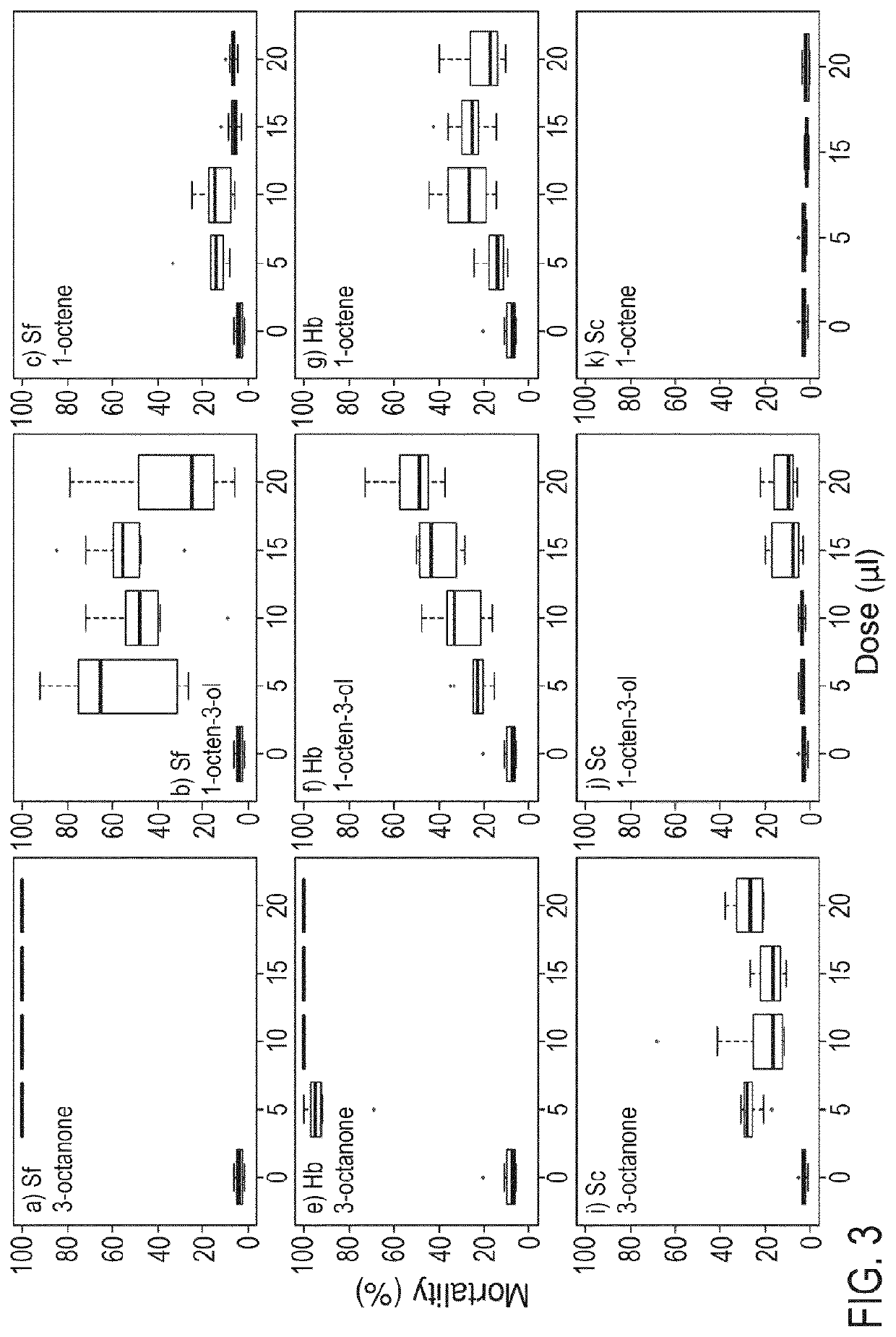Use of Volatile Organic Compounds as Pesticides
a technology of volatile organic compounds and pesticides, applied in the field of use of volatile organic compounds as pesticides, can solve the problems of causing billions of dollars' worth of damage to crops, affecting the production of agricultural crops, and reducing the use of volatile organic compounds, so as to avoid the difficulty or cost of acquisition or use, and avoid the undesirable effects of further active ingredients
- Summary
- Abstract
- Description
- Claims
- Application Information
AI Technical Summary
Benefits of technology
Problems solved by technology
Method used
Image
Examples
example 1
of 12 VOCs for Nematicidal Activity
[0065]Authenticated M. brunneum VOCs, along with other selected VOCs, were screened for nematicidal activity against S. feltiae and H. bacteriophora. 750 μl of nematode suspension containing approximately 5000 Us in tap water, was spread uniformly over the water agar surface (2.6% w / v agar, 5 mM potassium phosphate pH 6, 1 mM CaCl2 and 1 mM MgSO4) of a Petri dish. Each Petri dish (90 mm) contained 20 ml of the water agar medium. The inoculated plates were kept in darkness for 3 hr at room temperature to acclimatize. The plates were then exposed to 20 μl of the VOC dispensed from a 8 mm paper disc (Whatman™, 0.34 mm thickness) positioned on a 25×25 mm glass coverslip placed in the centre of the Petri dish lid (FIG. 1A). The plates were sealed with a double layer of Parafilm and were kept in the dark at 21° C. and checked after 24 hr. The number of live and dead nematodes were counted with the aid of a stereo binocular microscope (30×).
[0066]The tran...
example 2
ality Assay for the EPNs
[0069]Dose mortality assays were performed using 3-octanone and 1-octen-3-ol. The assays were performed as described in Example 1, except that the EPNs (S. carpocapsae (Sc), S. feltiae (Sf) and H. bacteriophora (Hb)) were exposed to different doses of the VOCs (5, 10, 15 and 20 μl). The mortality was recorded as described previously at 3, 6, 12 and 24 hr post treatment. Controls included EPNs only (no VOC) and EPNs+1-octene. The results are shown in FIG. 2 (results 3 hr post treatment), 3 (results 6 hr post treatment), 4 (results 12 hr post treatment) & 5 (results 24 hr post treatment).
[0070]The EPNs exhibited somewhat differential sensitivity to the nematicidal compounds at shorter exposure times (FIG. 2, FIG. 3). For example, following 6 hr exposure time S. feltiae was most sensitive, with S. carpocapsae being the most tolerant (FIG. 3). However, mortality was very high for all three EPNs exposed to 3-octanone or 1-octen-3-ol after 24 hr (FIG. 5). By contra...
example 4
al Effect of VOC Formulation
[0076]1-octen-3-ol (5% v / w) was mixed with microcrystalline cellulose and the wettable powder was mixed into soil containing a plant parasitic nematode at different concentrations (1, 5 and 10% w / w). The % decline in the population of adult and juveniles as well as eggs was recorded one day (black bars) and five days (grey bars) post treatment in the top (A), middle (B) and bottom (C) layers of soil. The results are shown in FIGS. 7a and 7b.
[0077]It can be seen from FIGS. 7a and 7b that the presence of the composition comprising 1-octen-3-ol and microcrystalline cellulose significantly decreases both the amount of adult and juvenile parasitic nematodes as well as the number of eggs. The compositions comprising a higher amount of 1-octen-3-ol generally achieved a higher level of decrease, i.e. achieved a higher level of mortality. The level of decrease measured was also generally higher at 5 days compared to 1 day showing that the nematodes were killed.
PUM
 Login to View More
Login to View More Abstract
Description
Claims
Application Information
 Login to View More
Login to View More - R&D
- Intellectual Property
- Life Sciences
- Materials
- Tech Scout
- Unparalleled Data Quality
- Higher Quality Content
- 60% Fewer Hallucinations
Browse by: Latest US Patents, China's latest patents, Technical Efficacy Thesaurus, Application Domain, Technology Topic, Popular Technical Reports.
© 2025 PatSnap. All rights reserved.Legal|Privacy policy|Modern Slavery Act Transparency Statement|Sitemap|About US| Contact US: help@patsnap.com



